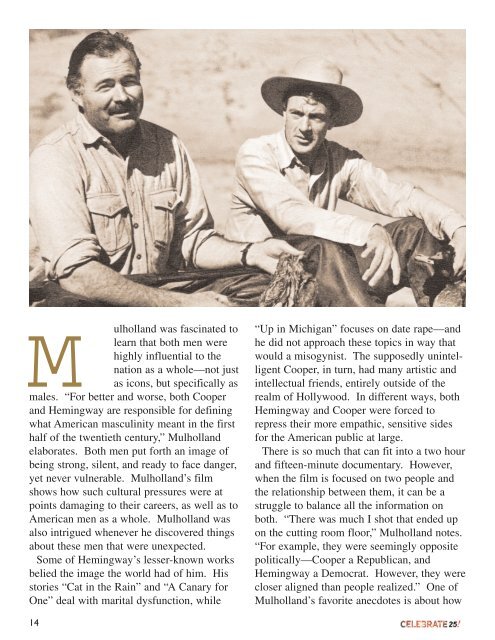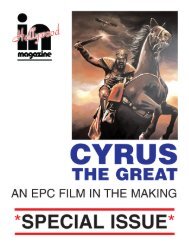ANNIVERSAY ISSUE 0717
Our Anniversary Issue to celebrate our 25th year in business
Our Anniversary Issue to celebrate our 25th year in business
Create successful ePaper yourself
Turn your PDF publications into a flip-book with our unique Google optimized e-Paper software.
M<br />
ulholland was fascinated to<br />
learn that both men were<br />
highly influential to the<br />
nation as a whole—not just<br />
as icons, but specifically as<br />
males. “For better and worse, both Cooper<br />
and Hemingway are responsible for defining<br />
what American masculinity meant in the first<br />
half of the twentieth century,” Mulholland<br />
elaborates. Both men put forth an image of<br />
being strong, silent, and ready to face danger,<br />
yet never vulnerable. Mulholland’s film<br />
shows how such cultural pressures were at<br />
points damaging to their careers, as well as to<br />
American men as a whole. Mulholland was<br />
also intrigued whenever he discovered things<br />
about these men that were unexpected.<br />
Some of Hemingway’s lesser-known works<br />
belied the image the world had of him. His<br />
stories “Cat in the Rain” and “A Canary for<br />
One” deal with marital dysfunction, while<br />
“Up in Michigan” focuses on date rape—and<br />
he did not approach these topics in way that<br />
would a misogynist. The supposedly unintelligent<br />
Cooper, in turn, had many artistic and<br />
intellectual friends, entirely outside of the<br />
realm of Hollywood. In different ways, both<br />
Hemingway and Cooper were forced to<br />
repress their more empathic, sensitive sides<br />
for the American public at large.<br />
There is so much that can fit into a two hour<br />
and fifteen-minute documentary. However,<br />
when the film is focused on two people and<br />
the relationship between them, it can be a<br />
struggle to balance all the information on<br />
both. “There was much I shot that ended up<br />
on the cutting room floor,” Mulholland notes.<br />
“For example, they were seemingly opposite<br />
politically—Cooper a Republican, and<br />
Hemingway a Democrat. However, they were<br />
closer aligned than people realized.” One of<br />
Mulholland’s favorite anecdotes is about how<br />
14




